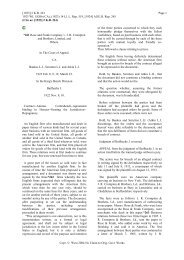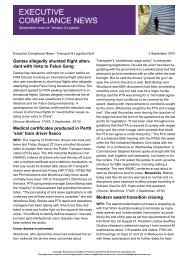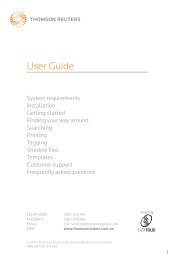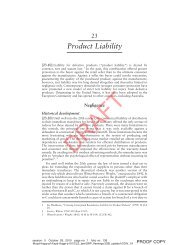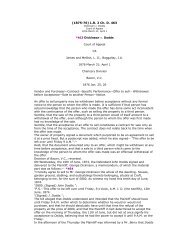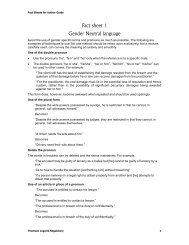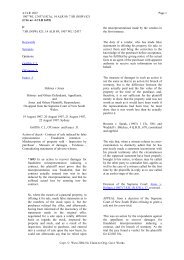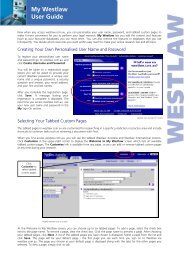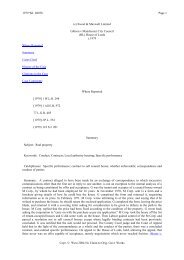Tesco v Constain - Thomson Reuters
Tesco v Constain - Thomson Reuters
Tesco v Constain - Thomson Reuters
Create successful ePaper yourself
Turn your PDF publications into a flip-book with our unique Google optimized e-Paper software.
2003 WL 21729349 Page 612003 WL 21729349 (QBD (T&CC)), [2003] EWHC 1487(Publication page references are not available for this document.)disclaimer. I wish to add in parenthesis that, asOliver J. recognised in HMidland Bank Trust Co.Ltd. v. Hett, Stubbs & Kemp [1979] Ch 384, 416F-G (a case concerned with concurrent liability ofsolicitors in tort and contract, to which I will haveto refer in a moment), an assumption ofresponsibility by, for example, a professional manmay give rise to liability in respect of negligentomissions as much as negligent acts ofcommission, as for example when a solicitorassumes responsibility for business on behalf of hisclient and omits to take a certain step, such as theservice of a document, which falls within theresponsibility so assumed by him."214. At page 194C-E of the report of Hendersonv. Merrett Syndicates Ltd. Lord Goff summarisedthe principle which he considered was applicable inthis way:--"But, for present purposes more important, in theinstant case liability can, and in my opinion should,be founded squarely on the principle established inHedley Byrne itself, from which it follows that anassumption of responsibility coupled with theconcomitant reliance may give rise to a tortiousduty of care irrespective of whether there is acontractual relationship between the parties, and inconsequence, unless his contract precludes himfrom doing so, the plaintiff, who has available tohim concurrent remedies in contract and tort, maychoose that remedy which appears to him to be themost advantageous."215. The passage which I have quoted in thepreceding paragraph followed a little way after thispassage, at pages 193G-194B, which set thecontext for it and which seems to me to provideuseful assistance in understanding it:--"It is however my understanding that by the lawin this country contracts for services do contain animplied promise to exercise reasonable care (andskill) in the performance of the relevant services;indeed, as Mr. Tony Weir has pointed out (XI Int.Encycl. Comp. L., ch. 12, para 67), in the 19thcentury the field of concurrent liabilities wasexpanded "since it was impossible for the judges todeny that contracts contained an implied promise totake reasonable care, at the least, not to injure theother party". My own belief is that, in the presentcontext, the common law is not antipathetic toconcurrent liability, and that there is no sound basisfor a rule which automatically restricts the claimantto either a tortious or a contractual remedy. Theresult may be untidy; but, given that the tortiousduty is imposed by the general law, and thecontractual duty is attributable to the will of theparties, I do not find it objectionable that theclaimant may be entitled to take advantage of theremedy which is most advantageous to him, subjectonly to ascertaining whether the tortious duty is soinconsistent with the applicable contract that, inaccordance with ordinary principle, the partiesmust be taken to have agreed that the tortiousremedy is to be limited or excluded."216. In the course of his speech Lord Goff didcomment, at page 186F, upon the passage from theadvice of the Privy Council in Tai Hing CottonMill Ltd. v. Liu Chong Hing Bank Ltd. which Ihave already quoted:--"It is however right to stress, as did Sir ThomasBingham MR in the present case, that the issue inthe Tai Hing case was whether a tortious duty ofcare could be established which was moreextensive than that which was provided for underthe relevant contract."217. At pages 195G-196C Lord Goff made someobservations as to the relevance to the issue of theexistence of a duty of care in tort of the contractualrelationships between the relevant parties, withspecific reference to the sort of contractualarrangements which are not uncommon in theconstruction industry:--"I wish however to add that I strongly suspectthat the situation which arises in the present case ismost unusual; and that in many cases in which acontractual chain comparable to that in the presentcase is constructed it may well prove to beinconsistent with an assumption of responsibilitywhich has the effect of, so to speak, short circuitingthe contractual structure so put in place by theparties. It cannot therefore be inferred from thepresent case that other sub-agents will be helddirectly liable to the agent's principal in tort. Letme take the analogy of the common case of anordinary building contract, under which maincontractors contract with the building owner for theconstruction of the relevant building, and the maincontractor sub- contracts with sub-contractors orsuppliers (often nominated by the building owner)for the performance of work or the supply ofmaterials in accordance with standards and subjectto terms established in the sub-contract. I put onone side cases in which the sub-contractor causesphysical damage to property of the building owner,where the claim does not depend on an assumptionof responsibility by the sub- contractor to thebuilding owner; though the sub-contractor may beprotected from liability by a contractual exemptionclause authorised by the building owner. But if thesub-contracted work or materials do not in theresult conform to the required standard, it will notordinarily be open to the building owner to sue thesub-contractor or supplier direct under the HedleyByrne principle, claiming damages from him on thebasis that he has been negligent in relation to theperformance of his functions. For there is generallyCopr. © West 2004 No Claim to Orig. Govt. Works



